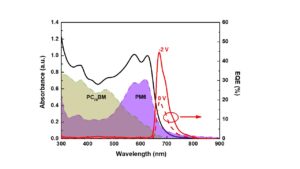Development of high-performance, air-stable selective photodetectors based on organic materials
To detect optical signals emitted at a specific wavelength, it is necessary to develop systems offering selective photodetection. For this wavelength-selective photodetection, or so-called color discrimination, organic photodetectors (OPDs) can offer significant advantages such as the possibility of low-temperature processing from solutions, the chemical versatility of the compounds and a specific spectral detection range. However, to avoid commonly used filters, designing a spectral narrowing approach that simultaneously achieves a selective detection range with a bandwidth of less than 50 nm and a spectral response of more than 20%, remains a challenge. OPDs based on the charge collection narrowing (CCN) principle can offer these features. In this approach, the detection window can be selected to match the onset of absorption of the materials used in the OPD. Here, we implement band-selective, filter-free OPDs based on state-of-the-art PM6:PC70BM blends. Fine tuning over a bandwidth of 42 nm to be highly selective at 677 nm with an efficiency of 48.4% under low polarization is achieved. Furthermore, using a non-invasive and non-destructive ALD encapsulation technique, we demonstrate that these OPDs fully retain their high selective peak after 30 days.

Towards air-stability of efficient filter-free band-selective organic photodetectors based on bulk heterojunction: avoiding environmental degradation with atomic layer deposition encapsulation.
Q. Eynaud, M. el Amine Kramdi, V. Kannampalli, T. Koganezawa, N. Yoshimoto, L. Santinacci, J. Ackermann, C. Videlot-Ackermann. Adv. Energy Sustainability Res. 2024, 2300262. DOI: 10.1002/aesr.202300262.
